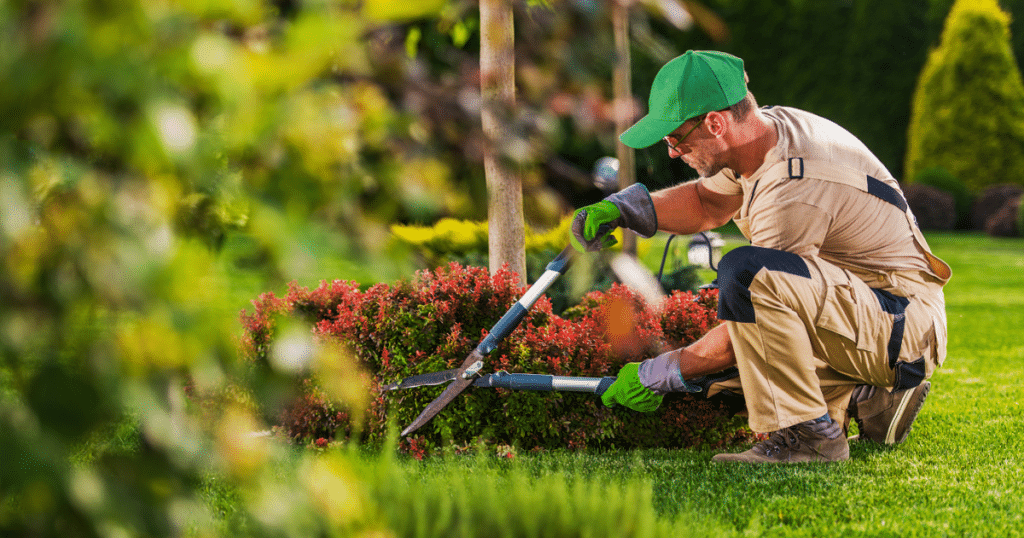
Calling all outdoor enthusiasts and garden gurus! Get ready to embark on a playful journey that unveils the secrets of landscaping magic. From creating breathtaking gardens to crafting captivating outdoor havens, we’ll take you through a wild adventure of horticulture, design finesse, and construction wizardry. So, buckle up and prepare to be enchanted as we reveal the secrets to transforming ordinary spaces into extraordinary landscapes!
To become a landscaper, you can start by obtaining a high school diploma or equivalent. Gain practical experience by working with experienced landscapers or completing internships. Consider pursuing relevant certifications or completing a landscaping program to enhance your skills and increase your job prospects.
Definition of Landscaping
Landscaping is the art of enhancing the natural beauty of a piece of land by modifying its contours, adding ornamental features like plants and rocks, and organizing outdoor space with furniture or structures like patios or decks. At its core, landscaping is about creating beauty in nature while preserving its integrity. But how to become a landscaper?
Professional landscapers use various tools such as lawnmowers, chainsaws, tillers, pruners knives to shape landscapes into desired designs. They use their expertise in horticulture to select plants that grow well in specific climates, along with maintenance techniques for those plants that ensure they thrive long-term.
RELATED: How Much to Hire a Landscaper: A Comprehensive Guide to Hiring a Professional Landscaper
Importance of Landscaping
Landscaping plays an essential role in our daily lives. It can help reduce stress levels by providing beautiful natural surroundings that promote relaxation and peace of mind. Beautifully designed landscapes can also improve property values significantly by increasing curb appeal.
Furthermore, landscaping has environmental benefits that extend beyond aesthetics; it can improve air quality by reducing pollution levels while also mitigating erosion caused by heavy rainfall or windstorms. It enhances biodiversity since gardens provide habitats for various species such as birds and bees.
Overview of Steps to Become a Landscaper
If you are interested in becoming a landscaper, these are some steps you can follow: 1)Complete high school education or equivalent -Enroll in a trade school or college
- Consider courses in horticulture, landscape architecture
- Gain Work Experience
- Apprenticeships – On-the-job training
- Skills Required – Creativity and design skills; Knowledge of plants, soil, and climate; Ability to use tools and equipment
- Licensing and Certification – Check state requirements for landscaper licensing. Consider certification from professional organizations. Becoming a landscaper requires a mix of technical, creative, and practical skills.
It may take time to gain experience before starting your own business or working with landscaping companies. However, the potential rewards are worth the effort as there is always a demand for well-trained, skilled landscapers.
Education and Training
High School Education or Equivalent
The first step towards becoming a landscaper is completing a high school education or its equivalent.
This is the foundation for all further educational pursuits and should be taken seriously. High school courses in botany, biology, chemistry, art, and mathematics form a strong basis for future studies in landscape architecture or horticulture.
While still in high school, students can gain practical experience by participating in gardening clubs or volunteering at public parks. Such programs offer the chance to learn about plants and their growth requirements, as well as an opportunity to work with various tools.
College Degree in Landscape Architecture or Horticulture
A college degree provides a more comprehensive understanding of plants, soil types, designing landscapes, erosion control measures, and environmental sustainability practices. A degree can also lead to job opportunities with higher salaries than those without one.
The two most common degrees for individuals interested in landscaping are landscape architecture and horticulture. Landscape architecture provides students with training on how to design outdoor spaces, including gardens, parks, playgrounds, and other recreational areas, while considering ecological factors such as water conservation measures.
Horticulture studies focus on plant production, including plant physiology as well as plant identification methods, while learning about different soil types that suit different plants’ needs. Horticulturists specialize in plant care which includes pest management techniques and disease control measures so that they can help maintain healthy gardens throughout the year.
Apprenticeships and On-the-job Training
Apart from formal education from universities, it is important for aspiring landscapers to gain practical on-the-job training through apprenticeships at established landscaping firms after completing their formal education.
An apprenticeship program allows novices to receive hands-on training from experienced landscapers. They learn how to operate equipment and tools, diagnose plant diseases, identify plants, and other skills necessary for the job.
Alternatively, some people can start working as assistants to experienced landscapers. While not formal apprenticeships this provides them with a chance to learn while gaining practical experience.
It helps them gain a more in-depth understanding of the industry’s day-to-day operations and how to manage projects. Both forms of training can help novices learn how to manage projects from start to finish; communicate effectively with clients; purchase materials needed for the project while staying within budget and timeframes; plan maintenance schedules for plants and structures in the project; coordinate different professionals like electricians or masons when their services are needed during different stages of the project.
Creative and Design Skills
As a landscaper, creativity, and design are essential skills for transforming outdoor spaces into aesthetically-pleasing and functional areas for clients. This involves conceptualizing designs, selecting plants, and arranging various elements such as sidewalks, patios, fountains, and other features to fit the desired design. Landscapers must have an eye for design and be able to visualize potential outcomes in three dimensions.
They may also need to consider the clients’ tastes or preferences when designing landscapes. The best landscapers can create unique designs that stand out while incorporating practical elements that enhance the overall functionality of the space.
Knowledge of Plants, Soil, and Climate
Becoming a successful landscaper requires having in-depth knowledge of plants, soil types, fertilizer requirements as well as how climate affects different elements in a landscape project. Landscapers must know which plants are native to an area so they can choose appropriate plants that thrive in specific environments.
Understanding soil types is equally important when dealing with certain plant species because different soils require different fertilization schedules. Additionally, understanding irrigation needs based on climate is important to ensure plant growth.
Ability to Use Tools and Equipment
Landscaping requires using various tools ranging from hand-held gardening tools such as shovels or pruning shears to larger equipment like lawnmowers or skid steers. Understanding how each tool works is necessary for efficient landscaping work.
With power tools being used frequently on a job site, including motorized saws or trimmers that pose injury risks if not handled properly, it is essential for landscapers to have knowledge of safety procedures when operating these pieces of machinery. The best way for beginners who lack experience with any particular piece of equipment would be shadowing another experienced worker who has been handling it on previous jobs before trying it out themselves.
Being skilled with creativity, understanding plants, soil, and climate, and proficiency in tool usage is just as important as a college degree or certification when considering becoming a landscaper. Aspiring landscapers must be willing to learn continuously throughout their careers to keep up with the industry’s latest trends and innovations.
Licensing and Certification
Landscaping is a regulated profession in most states, and aspiring landscapers are required to obtain a license before engaging in any landscaping activities. The licensing requirements vary by state, but they typically involve passing an exam and meeting certain education and experience requirements.
State licensing requirements for landscapers
Each state has its own specific requirements for obtaining a landscaping license, so it’s important to check with your state’s licensing board to determine the exact steps you need to take. However, there are some commonalities across most states. For instance, most states require that you have a minimum amount of education or experience in the field before applying for a license.
This may include completing a formal training program or apprenticeship or working in the field for a certain number of years. In addition to meeting educational and experience requirements, most states require that you pass an exam before obtaining your license.
The exam typically covers topics such as plant identification, soil science, landscape design principles, hardscape installation techniques, safety procedures, and business management skills. It’s important to thoroughly prepare for this exam so that you can pass on your first attempt.
Some states also require landscapers to carry liability insurance or obtain bonding as a condition of licensure. Liability insurance protects you from financial loss if someone is injured or their property is damaged while on the job site; bonding provides financial protection to clients if you fail to complete work as promised.
Certification from professional organizations
In addition to state licensure requirements, many professional organizations offer certification programs that recognize expertise in specific areas of landscaping. These certifications can help boost your resume and give clients added confidence in your skills.
The International Society of Arboriculture (ISA) offers several certifications related specifically to tree care, such as Certified Arborist, Certified Tree Worker, and Certified Tree Care Safety Professional. These certifications require a combination of education and experience, as well as passing an exam.
The National Association of Landscape Professionals (NALP) offers several certifications in areas ranging from landscape design to maintenance to irrigation. These certifications require a combination of education and experience, as well as passing an exam.
The Irrigation Association (IA) offers several certifications related specifically to irrigation system design and installation. These certifications require a combination of education and experience, as well as passing an exam.
Obtaining certification from professional organizations can help you stand out in the competitive world of landscaping. It shows potential clients that you are committed to ongoing education and professional development in your field.
Business Skills
As a landscaper, it’s important to have a basic knowledge of business management. This includes understanding budgeting and financial planning, as well as knowing how to prepare invoices, estimates, and contracts.
Having good communication skills is also essential when dealing with clients, employees, and suppliers. To gain this knowledge, there are several resources available.
Many colleges and universities offer courses in business management that are specifically tailored to the landscaping industry. Additionally, industry associations such as the National Association of Landscape Professionals (NALP) offer educational programs that cover various aspects of business management.
Marketing and Advertising Strategies
In order to attract customers and build a successful landscaping business, it’s important to have effective marketing and advertising strategies in place. This can include creating a strong brand identity through logos and promotional materials, building a website that showcases your work, utilizing social media platforms for online marketing campaigns, and attending trade shows and events where you can network with potential customers or other professionals in the industry.
One effective way to market your services is through word-of-mouth referrals from satisfied clients. Encouraging your current clients to recommend you to family members or friends can help generate new leads for your business.
Financial Planning
One key aspect of running any successful business is having solid financial planning strategies in place. This includes setting realistic goals for revenue growth each year and tracking expenses carefully so you can identify areas where cost savings may be possible.
In addition to creating a budget for your company’s ongoing expenses, such as equipment maintenance or employee salaries/benefits packages – you should also plan ahead so that you have enough cash flow on hand when unexpected expenses arise. To keep track of all these financial details – many landscapers use specialized software programs designed specifically for this purpose – some examples include QuickBooks Pro or Sage 50 Accounting Software.
Overall – having strong business and financial management skills as a landscaper is essential to building a successful career in this industry. Whether you’re just starting out or looking to take your business to the next level – investing in education and training related to these topics can pay off over time through increased profitability and customer satisfaction.
Working as a Landscaper
Types of Jobs Available in the Landscaping Industry
The landscaping industry offers a wide range of jobs, from entry-level positions to management roles. Some common job titles include landscaper, crew leader, garden designer, landscape architect, and project manager.
Landscapers perform basic tasks like mowing lawns and planting flowers, while garden designers create plans for outdoor spaces that may include water features and hardscaping elements like patios. Landscape architects take their designs to the next level by creating blueprints and overseeing the construction of large-scale projects.
Working as an Independent Contractor vs. Working for a Company
One decision you’ll have to make when pursuing a career in landscaping is whether to work as an independent contractor or for a company. Independent contractors have more control over their schedules and can set their own rates, but they also have to handle all aspects of the business themselves – including marketing, accounting, and client communication. Working for a company may mean less flexibility but more stability with benefits such as health insurance and retirement plans.
There are pros and cons to both options: working for a company typically provides steadier work but may not offer the creative freedom that comes with being self-employed. Those who choose to work independently enjoy higher earnings potential but must be comfortable with self-promotion.
Typical Workday for a Landscaper
A typical day in the life of a landscaper can vary depending on the season, weather conditions, location, type of job site, or project assigned. Generally speaking, though, most landscapers start early in the morning before temperatures rise too high during summer months – around 6 am – or later throughout spring & fall seasons when daylight hours are shorter. Tasks commonly performed by landscapers throughout the day include mowing lawns, pruning trees & shrubs; trimming hedges & bushes; planting flowers, trees, and other plants; installing irrigation systems; creating garden designs using CAD software or by hand drawing sketches; and performing basic maintenance on various tools, equipment, and machinery.
In addition to these physical tasks, landscapers often interact with clients to discuss their needs, provide recommendations based on experience with previous projects they have completed, and answer questions about the process. Many landscapers also write quotes for jobs large or small and negotiate pricing with customers.
Overall, it’s essential for landscapers to be organized and self-motivated as they juggle multiple tasks throughout the day – from meeting with clients to completing physical labor – while maintaining a high level of quality workmanship. A career in landscaping can be challenging but also quite rewarding for those who enjoy working outside and seeing their creative visions come to life.

Future Trends in Landscaping
Environmentally Friendly Landscaping Practices
As the world becomes more aware of environmental issues, the landscaping industry has seen a shift towards more sustainable and eco-friendly practices. One trend is the use of native plants in landscaping designs, as they require less water and maintenance than imported species. In addition, more landscapers are incorporating rain gardens and bioswales, which are designed to capture and filter stormwater runoff.
Another trend is the use of organic fertilizers and pest control methods, which reduce the amount of harmful chemicals used in landscaping. Some landscapers are also implementing composting practices to reduce waste and improve soil health.
The concept of “edible landscapes” is also becoming popular, where homeowners grow fruits and vegetables alongside ornamental plants. This not only provides fresh produce for residents but also promotes biodiversity.
Green roofs and walls are increasingly being incorporated into design plans. These features help to insulate buildings from temperature fluctuations and improve air quality in urban areas.
New Technology Used in The Industry
The use of technology is revolutionizing the landscaping industry. One such technology is 3D modeling software that allows landscapers to create realistic digital representations of their designs before implementation.
This helps clients visualize their ideal landscape while allowing landscapers to identify any potential issues before construction begins. Another technological advancement is smart irrigation systems that automatically adjust watering schedules based on weather conditions and soil moisture levels.
This reduces water waste, lowers utility bills for homeowners, and promotes healthier plant growth. Robot mowers are another innovation that can save time for both homeowners and landscapers alike.
These devices operate autonomously on pre-programmed schedules to keep lawns trimmed without human intervention. Drones are being used by some landscapers for aerial surveys of properties prior to beginning a project or inspecting hard-to-reach areas like rooftops or tall trees.
Frequently Asked Questions
What degree is best for a landscaper?
The degree most beneficial for a landscaper is typically a Bachelor’s degree in Landscape Architecture or a related field, although formal education is not always required, and hands-on experience can be valuable.
What do landscapers do?
Landscapers design, install, and maintain outdoor spaces, including gardens, parks, and residential or commercial landscapes. They may plant trees and flowers, install irrigation systems, lay pathways, and provide ongoing maintenance.
How do I become a landscaper in Canada?
To become a landscaper in Canada, you can pursue a variety of paths. Some options include completing a relevant apprenticeship program, obtaining a diploma or degree in landscaping or horticulture, or gaining practical experience through on-the-job training.
What is a landscape gardener?
A landscape gardener is a professional who specializes in designing and creating aesthetically pleasing gardens. They focus on elements such as plant selection, layout, and overall garden design to create visually appealing outdoor spaces.
What is the highest-paid landscaper?
The highest-paid landscapers are typically those with extensive experience, advanced skills, and specialized expertise, such as landscape architects or senior landscape designers who work on high-profile projects or for prestigious firms.
Which career is related to landscaping?
A related career to landscaping is horticulture, which involves the study and cultivation of plants. Horticulturists work in various sectors, including plant nurseries, botanical gardens, agricultural settings, and landscaping companies, focusing on plant growth, cultivation techniques, and plant-related research and development.
Conclusion
Summary of the key points discussed
Becoming a successful landscaper requires a mix of education, training, skills, licensing and certification, business acumen, and hard work. A high school education or equivalent is necessary but not sufficient to become a landscaper.
It is highly recommended to pursue a college degree in landscape architecture or horticulture. In addition to formal education, apprenticeships and on-the-job training can provide valuable hands-on experience.
Creativity and design skills are essential for creating beautiful outdoor spaces that meet client’s needs and preferences. Knowledge of plants, soil, and climate conditions is critical for the health and growth of plants.
The ability to use tools and equipment safely and efficiently is crucial for working in the field. State licensing requirements vary by state but typically include passing a written exam or demonstrating experience in the industry.
Certification from professional organizations such as the National Association of Landscape Professionals (NALP) can provide credibility and recognition. Basic business management knowledge, such as accounting skills and marketing strategies, are also essential for starting your landscaping business or advancing your career as an independent contractor.
RELATED: How Much Does a Landscaper Make: Uncovering the Lucrative World of Landscaping Salaries
Encouragement to pursue a career in
Landscaping is an enjoyable career with unlimited potential for creativity and personal satisfaction. As communities continue to expand with new homes being built every day, there will be an increasing demand for professional landscaping services. The future of landscaping looks bright, with new technologies emerging every year that allows landscapers to create even more efficient irrigation systems while using fewer resources.
Furthermore, people are increasingly interested in environmentally conscious landscaping practices that help reduce water usage while creating beautiful outdoor spaces that improve air quality. If you find joy in working outdoors and enjoy seeing the transformation of landscapes into something truly special, it could be time to consider pursuing a career as a landscaper.
Remember that this article only covers some aspects of becoming a successful landscaper, so you should continue to research and learn about the industry as much as possible. With enough determination, dedication, and hard work, anyone can become a successful landscaper.






